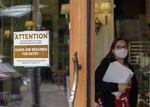Just 41 intensive care unit beds were available in Oregon on Wednesday as COVID-19 cases continue to climb and hospitals near capacity in a state that was once viewed as a pandemic success story.

FILE - In this May 21, 2021 file photo, a sign reminds customers to wear their masks at a bakery in Lake Oswego, Ore. As of Wednesday, Aug. 18, 2021, just 41 intensive care unit beds were available in Oregon, as COVID-19 cases continue to climb and hospitals near capacity in a state that was once viewed as a pandemic success story. Oregon, which earlier had among the lowest cases per capita, is now shattering its COVID-19 hospitalization records day after day. (AP Photo/Gillian Flaccus, File)
Gillian Flaccus / OPB
Oregon, which earlier had among the lowest cases per capita, is now shattering its COVID-19 hospitalization records day after day. Oregon — like Florida, Arkansas and Louisiana — has had more people in the hospital with COVID-19 than at any other point in the pandemic.
As of Wednesday, 850 coronavirus patients were hospitalized in Oregon — surpassing the state’s record, which was set the previous day. Before this month, the hospitalization record was 622 in November, during a winter surge and when vaccines were not yet available.
More than a third of the state’s 652 adult ICU beds are being used for COVID-19 patients. Health officials say that the overwhelming majority of hospitalized virus patients are unvaccinated.
For more than a year Oregon faced some of the nation’s strictest safety measures — county risk levels, mask requirements inside and outside, limited gatherings and restaurants closed for indoor dining. Health officials say the state's consistently low COVID-19 case counts throughout the pandemic can be attributed to tight restrictions.
On June 30, Gov. Kate Brown officially lifted coronavirus restrictions. At the time 136 people with COVID-19 were hospitalized.
But as safety measures were removed, and the highly transmissible delta variant tore through the state, COVID-19 cases rapidly increased.
Earlier this month, Renee Edwards, the chief medical officer at Oregon Health & Science University, said that Oregon’s low “immunity level as a state when considering previous infections" and the number of vaccinated people has placed the state at high risk for new infections.
For weeks Oregon health officials have warned that COVID-19 cases, fueled by the highly transmissible delta variant, would fill hospitals by September if infection rates didn't slow significantly. Now, a little more than halfway through the month of August, 94% of the state’s hospital beds for adults and 93% of ICU beds are full.
“When our hospitals, emergency departments, and ICUs are full, that means a staffed hospital bed may not be available when you and your family need urgent or intensive care, whether for COVID-19, or a car crash, or a heart attack or stroke,” Gov. Kate Brown said via Twitter on Tuesday.
Oregon divides the state into hospital regions to better coordinate emergency response. In hospital region two in western Oregon — which consists of Benton, Lincoln, Linn, Marion, Polk and Yamhill counties — officials report that there are zero ICU beds left.
Other hospital regions are heading towards full capacity as well.
In hospital region one — which is home to Oregon's most populous counties and where about half of the state's hospital and ICU beds are located — there are 17 adult ICU beds left.
State health officials have warned that, without health and safety interventions in place, hospitalizations will far exceed the health system capacity in coming weeks. Officials at Oregon Health & Science University estimate that the state will be short by as many as 500 hospital beds by early September.
Despite new safety and health measures — including vaccine requirements for health care workers and state employees and a statewide indoor mask mandate for everyone, regardless of vaccination status — Oregon continues to report all-time high COVID-19 numbers.
On Friday 500 National Guard members will be deployed to serve as equipment runners in the most stricken hospitals and help with testing.
In an attempt keep hospital beds open, health systems across Oregon have opted to postpone elective procedures, nurses and physicians say they are overwhelmed and health officials are desperately urging people to get vaccinated and wear masks.
—-
Sara Cline is a corps member for the Associated Press/Report for America Statehouse News Initiative. Report for America is a nonprofit national service program that places journalists in local newsrooms to report on undercovered issues.
